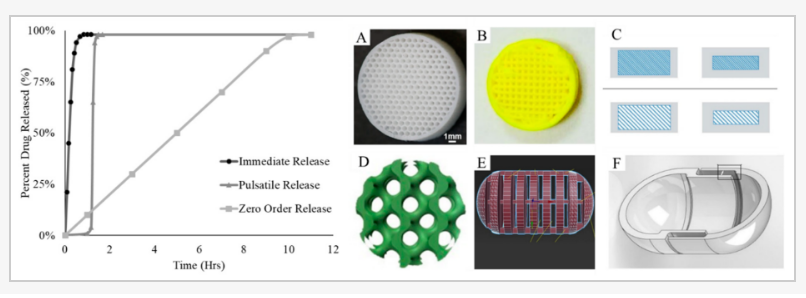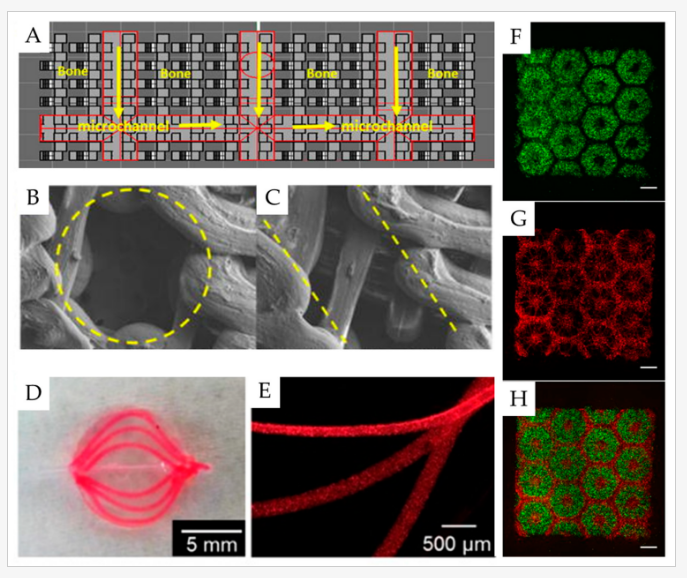Utah State University: 3D Printing for Pharmaceuticals on the Micro Scale
In ‘Application of Micro-Scale 3D Printing in Pharmaceutics,’ authors Andrew Kjar and Yu Huang of Utah State University examine the advantages of fabricating drugs on the micro-scale. As they point out, creating 3D printed drug delivery systems can be difficult due to challenges in reaching the specific target—without side effects whenever possible.
The ability to create patient-specific treatment has been limited also, mainly because through traditional methods, it is challenging to produce a dose size for every patient—leading to the splitting of doses. Most manufacturers also find it difficult to vary dose shapes.
“Inflexible dosage regimes highlight a need in the pharmaceutical industry that cannot be met through current manufacturing methods,” state the researchers. “Thus, innovative solutions are necessary.”

Typical additive manufacturing mechanisms. Additive manufacturing techniques are classified by their deposition of material in a layer-by-layer fashion. Material extrusion (A) traditionally deposits thermoplastic materials, but also includes pneumatic and mechanical deposition of semisolid materials. Both material jetting (B) and binder jetting (C) rely on familiar inkjet heads; in material jetting the entire print material passes through the nozzle, while in binder jetting, only a binder is deposited. An advantage of binder jetting is the support of the powder bed, negating the need for support structures or sacrificial material. This mechanism is also seen in selective laser sintering (D), where the powder bed is selectively fused by a laser. Finally, stereolithography (E) selectively polymerizes a liquid resin vat, thereby producing the desired part.

Maximum feature resolution of various 3D printing techniques, as compared to typical biological entities. Most techniques can print in the range of microvasculature; expensive, specialized methods, such as two-photon polymerization (2PP) and electrospinning hybrid extrusion (ME + E) are required for printing sizes comparable to single cells. Material extrusion (ME) feature resolution is essentially limited by nozzle size, while material jetting (MJ) and binder jetting (BJ) feature resolution is limited to droplet size. Binder jetting and selective laser sintering (SLS) feature resolution both depend on particle powder size, while stereolithography (SLA) has superior feature resolution based on the light source. However, for all print types, feature resolution depends highly on the designed geometry and print orientation. Data was compiled from manufacturer technical specification sheets and literature.
Innovative drug systems are being created in labs around the world via 3D printing and additive manufacturing processes, specifically for delivery and devices like tablets. Spritam is an example of the one of the most famous 3D printed drugs—as well as the first to be approved by the FDA. Novel dosage pills are being created, along with more streamlined drug delivery systems.

Idealized release profiles (left) and micro-geometry incorporation in oral dosages produced by additive manufacturing techniques (A–F). Immediate release is desirable for quick action drugs, such as pain relievers. Immediate release profiles are correlated to infill percentage (A) [91], and other factors such as wettability. Infill percentage may also be exploited for gastro-floating devices (B) [94]. If combined with a shell of variable thickness (C) [96], infill variation can also achieve tunable zero-order release. More complicated geometries offer release profiles that are dependent on erosion, providing immediate release profiles (D,E) [34,55]. Additionally, pulsatile release is possible with the fabrication of an outer shell of tunable thickness, here designed to be 600 microns (F) [33]. Reproduced with permission from Elsevier (A–F).
“Hypodermal needles are common for drug delivery in which oral ingestion is inappropriate; the method, however, is invasive,” explain the researchers. “Additive manufacturing provides alternative solutions for minimally invasive delivery through the design of microneedle arrays.”
These arrays are beneficial in:
- Improving patient compliance
- Decreasing pain and tissue damage
- Decreasing need for skilled healthcare professionals for administration
- Inhibiting microbial entrance
“Additionally, transdermally delivered drugs can elicit a higher immunogenic response and increased bioavailability,” state the researchers, while also pointing out that 3D printing of microneedle arrays is still constrained by feature resolution.
These arrays do, however, show potential for prolonged release—especially with the use of inkjet 3D printing. And as drug delivery systems often include extremely specific targets (cancer treatments, for example), those may difficult to reach. Both micro-swimmer devices and micro implants have been created to solve these issues. Drug release may often be ‘biphasic,’ with one short release of medication then followed by a longer one (in some cases, up to 80 days). The researchers state that there are ‘clear benefits’ to the uses of such 3D printed devices.
3D printed models also offer a host of benefits to everyone involved in the medical realm—from the patient and their family to the doctor and the surgeon—to medical students. Along with being helpful in diagnosis and treatment, 3D printed models can also be of enormous assistance in surgeries. And while models have made an enormous impact in patient-specific treatment, there is, of course, the goal of creating human organs for transplant. Today, bioprinting has progressed to allow impressive tissue engineering, most commonly of the following:
- Skin
- Liver
- Bone
- Cartilage
- Cardiac
- Adipose tissue
“The goal of engineering systems is to provide the optimal cell response for use in drug development, allowing for data with better translational and predictive qualities. Besides the use of bioprinted scaffolds for application in drug discovery and organ-on-a-chip and microfluidic devices are also emerging as alternatives that may be created via additive manufacturing,” conclude the researchers.
“The future is bright for the use of additive manufacturing in the pharmaceutical field; however, this future is not without obstacles.”

Examples of microstructured tissue constructs made via additive manufacturing techniques. Vascularization is a major component of functional tissue, and may be printed by leaving micron size spaces in the CAD file; 500-micron spaces are designed in this model (A–C) [15]. Another approach involves the printing of sacrificial material (D,E) [143]. Finally, tissues function depends on desired arrangement of cells, which may be achieved by direct bioprinting (F–H) [144]. Hepatic progenitor cells are marked in green, whereas support cells are marked in red. Scale bar: 500 µm. Vascularized, functional tissue provides better data for drug development. Reproduced with permission from Wiley (A–C), AIP (D,E), and PNAS (F–H).

Representative commercial printers with their associated feature resolutions and applications in the literature. Feature resolution data is taken from manufacturer technical specification sheets. Material extrusion values extracted from specification sheets are based on nozzle diameter. However, the smallest feature size is dependent on geometry, print speed, temperature, and material, and is not standardly reported. High-resolution printing techniques find applications in the printing of oral dosages, microneedles, micro-swimmers, and micro-implants. Material extrusion is a popular technique in the printing of oral dosages, whereas the feature resolution of stereolithography and two-photon polymerization are necessary for use in microneedles and micro-swimmers.
Subscribe to Our Email Newsletter
Stay up-to-date on all the latest news from the 3D printing industry and receive information and offers from third party vendors.
Print Services
You May Also Like
3D Printing News Briefs & Events Roundup: March 15, 2025
In this weekend’s combined 3D Printing News Briefs and Webinars/Events Roundup, we’re covering news about automotive and construction 3D printing, along with AM Forum, TCT Asia, the Experience Stratasys Tour,...
3D Printing News Briefs & Events Roundup: March 8, 2025
Starting this week, we’re shaking things up a little! We’ll be combining our 3D Printing News Briefs with a more curated weekly list of 3D printing webinars and events to...
Combinatory Manufacturing, Happening at Last?
In 2009, I introduced the concept of “combinatory manufacturing” while at Shapeways. This approach integrates 3D-printed components with conventionally manufactured ones to create end-use products. Unlike merely using 3D printing...
Boston’s Additive Edge: Fluent Metal’s Approach to Liquid Metal 3D Printing
Stepping into the heart of Boston’s innovation landscape, I found myself at Fluent Metal’s headquarters in Cambridge. From the moment I walked through the doors of the startup’s space, the...

























